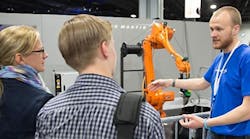How can we prepare the next generation for promising and rewarding careers?
America’s manufacturers have the answer, and on Oct. 7—Manufacturing Day—they’re opening their doors so that anyone can get a glimpse.
Manufacturers across the country will welcome students, teachers and parents onto their shop floors and into their businesses to demonstrate the opportunities modern manufacturing offers—and show that it looks nothing like the 1950s factories they see in grainy videos.
They will see the high-paying jobs that manufacturers create—from engineers and designers to marketers and executives. They will view the life-changing products they provide and the incredible value they bring to our communities and our country. It’s a chance to show how manufacturing is building a brighter future for everyone.
It’s also a day to consider what manufacturing needs to continue flourishing: especially talented, driven people.
Manufacturing Now and in the Future
More than 250,000 manufacturing businesses employ more than 12 million people who earn an average of nearly $80,000 a year in pay and benefits—nearly 24% more than the average worker. The vast majority of these firms are small manufacturers; in fact, three-quarters of manufacturing firms have fewer than 20 employees.
All told, manufacturing contributes more than $2 trillion a year to the economy, and for every $1 spent in manufacturing, another $1.81 is added to the economy. If manufacturing in the United States were its own country, it would have the ninth-largest economy in the world.
America’s success depends on manufacturing’s success. No wonder nine out of 10 of our fellow citizens see it as a critical part of our country’s economy.
And that’s why we must look to manufacturing’s future—and the problems that we must solve.
Today, modern manufacturing is on the cutting edge of innovation, making everything from cancer-fighting medicines to unmanned aerial vehicles, sustainable packing materials to phones and even the Internet of Things, which is already transforming how we go about our daily lives.
It’s also on the cutting edge of providing a rewarding career. Manufacturing gives people the ability to combine new technology with the time-tested skills of creativity, problem-solving and self-expression. Whatever you can dream, you can make it manufacturing.
Manufacturing Skills Gap
But manufacturing is also facing an acute crisis—a skills crisis.
Few families prioritize a manufacturing career for their children, even though it comes with high pay, good benefits and seemingly infinite possibilities for personal growth and fulfillment. According to research from Deloitte and The Manufacturing Institute, fewer than two out of five parents urge their children to pursue a manufacturing job. Not even one of five sees it as a top option.
This is a shame. Some 80% of manufacturers in the United States are already facing a shortage of skilled workers, due in no small part to the “skills gap” between potential hires and available jobs.
This gap is expected to grow in the months and years ahead. In the next decade, manufacturers will create an impressive 3.5 million jobs. But 2 million of those jobs will go unfilled. Every unfilled job is a missed opportunity for someone to find a stable, secure career that rewards them for the rest of their life.
It isn’t for a lack of interest from manufacturers. Four out of five industry executives are ready and willing to pay above-market wages in areas where talent is hard to find.
Bridging this skills gap—and unleashing the manufacturing of tomorrow—is among the most critical issues of our time.
Many manufacturers are already doing what they can to prepare today’s students for tomorrow’s jobs. But they need help.
We need families to reflect on how a manufacturing career is filled with endless possibilities for their children. We need schools to help train young adults with the practical skills necessary for the 21-century economy. And we need policymakers to ensure that anyone—no matter who they are or where they come from—is able to climb the ladder of opportunity and, through manufacturing, contribute to the world around them.
America’s story is the story of manufacturing. So on Manufacturing Day, Friday, Oct. 7, come onto our shop floors and see what the next chapter looks like. Visit www.mfgday.com to find a location near you.
Jay Timmons is president and CEO of the National Association of Manufacturers (NAM), and Tom Riordan is president and CEO of Neenah Enterprises and chair of the NAM Small and Medium Manufacturers Group.



